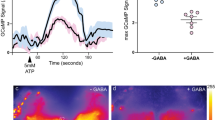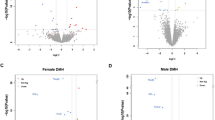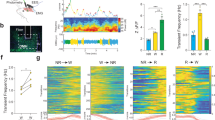Abstract
Sleep is required to maintain physiological functions, including memory, and is regulated by monoamines across species. Enhancement of dopamine signals by a mutation in the dopamine transporter (DAT) decreases sleep, but the underlying dopamine circuit responsible for this remains unknown. We found that the D1 dopamine receptor (DA1) in the dorsal fan-shaped body (dFSB) mediates the arousal effect of dopamine in Drosophila. The short sleep phenotype of the DAT mutant was completely rescued by an additional mutation in the DA1 (also known as DopR) gene, but expression of wild-type DA1 in the dFSB restored the short sleep phenotype. We found anatomical and physiological connections between dopamine neurons and the dFSB neuron. Finally, we used mosaic analysis with a repressive marker and found that a single dopamine neuron projecting to the FSB activated arousal. These results suggest that a local dopamine pathway regulates sleep.
This is a preview of subscription content, access via your institution
Access options
Subscribe to this journal
Receive 12 print issues and online access
$209.00 per year
only $17.42 per issue
Buy this article
- Purchase on Springer Link
- Instant access to full article PDF
Prices may be subject to local taxes which are calculated during checkout








Similar content being viewed by others
References
Crocker, A., Shahidullah, M., Levitan, I.B. & Sehgal, A. Identification of a neural circuit that underlies the effects of octopamine on sleep:wake behavior. Neuron 65, 670–681 (2010).
Kohatsu, S., Koganezawa, M. & Yamamoto, D. Female contact activates male-specific interneurons that trigger stereotypic courtship behavior in Drosophila. Neuron 69, 498–508 (2011).
Hendricks, J.C. et al. Rest in Drosophila is a sleep-like state. Neuron 25, 129–138 (2000).
Shaw, P.J., Cirelli, C., Greenspan, R.J. & Tononi, G. Correlates of sleep and waking in Drosophila melanogaster. Science 287, 1834–1837 (2000).
Agosto, J. et al. Modulation of GABAA receptor desensitization uncouples sleep onset and maintenance in Drosophila. Nat. Neurosci. 11, 354–359 (2008).
Andretic, R., van Swinderen, B. & Greenspan, R.J. Dopaminergic modulation of arousal in Drosophila. Curr. Biol. 15, 1165–1175 (2005).
Kume, K., Kume, S., Park, S.K., Hirsh, J. & Jackson, F.R. Dopamine is a regulator of arousal in the fruit fly. J. Neurosci. 25, 7377–7384 (2005).
Yuan, Q., Joiner, W.J. & Sehgal, A. A sleep-promoting role for the Drosophila serotonin receptor 1A. Curr. Biol. 16, 1051–1062 (2006).
Kume, K.A Drosophila dopamine transporter mutant, fumin (fmn), is defective in arousal regulation. Sleep Biol. Rhythms 4, 263–273 (2006).
Ueno, T., Masuda, N., Kume, S. & Kume, K. Dopamine modulates the rest period length without perturbation of its power law distribution in Drosophila melanogaster. PLoS ONE 7, e32007 (2012).
Ueno, T., Tomita, J., Kume, S. & Kume, K. Dopamine modulates metabolic rate and temperature sensitivity in Drosophila melanogaster. PLoS ONE 7, e31513 (2012).
Wisor, J.P. et al. Dopaminergic role in stimulant-induced wakefulness. J. Neurosci. 21, 1787–1794 (2001).
Shang, Y. et al. Imaging analysis of clock neurons reveals light buffers the wake-promoting effect of dopamine. Nat. Neurosci. 14, 889–895 (2011).
Lebestky, T. et al. Two different forms of arousal in Drosophila are oppositely regulated by the dopamine D1 receptor ortholog DopR via distinct neural circuits. Neuron 64, 522–536 (2009).
Draper, I., Kurshan, P.T., McBride, E., Jackson, F.R. & Kopin, A.S. Locomotor activity is regulated by D2-like receptors in Drosophila: an anatomic and functional analysis. Dev. Neurobiol. 67, 378–393 (2007).
Andretic, R., Kim, Y.C., Jones, F.S., Han, K.A. & Greenspan, R.J. Drosophila D1 dopamine receptor mediates caffeine-induced arousal. Proc. Natl. Acad. Sci. USA 105, 20392–20397 (2008).
Kong, E.C. et al. A pair of dopamine neurons target the D1-like dopamine receptor DopR in the central complex to promote ethanol-stimulated locomotion in Drosophila. PLoS ONE 5, e9954 (2010).
Van Swinderen, B. & Andretic, R. Dopamine in Drosophila: setting arousal thresholds in a miniature brain. Proc. Biol. Sci. 278, 906–913 (2011).
Waddell, S. Dopamine reveals neural circuit mechanisms of fly memory. Trends Neurosci. 33, 457–464 (2010).
Aso, Y. et al. Specific dopaminergic neurons for the formation of labile aversive memory. Curr. Biol. 20, 1445–1451 (2010).
Claridge-Chang, A. et al. Writing memories with light-addressable reinforcement circuitry. Cell 139, 405–415 (2009).
Liu, C. et al. A subset of dopamine neurons signals reward for odour memory in Drosophila. Nature 488, 512–516 (2012).
Joiner, W.J., Crocker, A., White, B.H. & Sehgal, A. Sleep in Drosophila is regulated by adult mushroom bodies. Nature 441, 757–760 (2006).
Pitman, J.L., McGill, J.J., Keegan, K.P. & Allada, R. A dynamic role for the mushroom bodies in promoting sleep in Drosophila. Nature 441, 753–756 (2006).
Diekelmann, S. & Born, J. The memory function of sleep. Nat. Rev. Neurosci. 11, 114–126 (2010).
Tomita, J. et al. Pan-neuronal knockdown of calcineurin reduces sleep in the fruit fly, Drosophila melanogaster. J. Neurosci. 31, 13137–13146 (2011).
Li, X., Yu, F. & Guo, A. Sleep deprivation specifically impairs short-term olfactory memory in Drosophila. Sleep 32, 1417–1424 (2009).
Kim, Y.C., Lee, H.G. & Han, K.A. D1 dopamine receptor dDA1 is required in the mushroom body neurons for aversive and appetitive learning in Drosophila. J. Neurosci. 27, 7640–7647 (2007).
Young, J.M. & Armstrong, J.D. Structure of the adult central complex in Drosophila: organization of distinct neuronal subsets. J. Comp. Neurol. 518, 1500–1524 (2010).
Liu, G. et al. Distinct memory traces for two visual features in the Drosophila brain. Nature 439, 551–556 (2006).
Sugamori, K.S., Demchyshyn, L.L., McConkey, F., Forte, M.A. & Niznik, H.B. A primordial dopamine D1-like adenylyl cyclase–linked receptor from Drosophila melanogaster displaying poor affinity for benzazepines. FEBS Lett. 362, 131–138 (1995).
Connolly, J.B. et al. Associative learning disrupted by impaired Gs signaling in Drosophila mushroom bodies. Science 274, 2104–2107 (1996).
Donlea, J.M., Thimgan, M.S., Suzuki, Y., Gottschalk, L. & Shaw, P.J. Inducing sleep by remote control facilitates memory consolidation in Drosophila. Science 332, 1571–1576 (2011).
Feinberg, E.H. et al. GFP reconstitution across synaptic partners (GRASP) defines cell contacts and synapses in living nervous systems. Neuron 57, 353–363 (2008).
Gordon, M.D. & Scott, K. Motor control in a Drosophila taste circuit. Neuron 61, 373–384 (2009).
Lai, S.L. & Lee, T. Genetic mosaic with dual binary transcriptional systems in Drosophila. Nat. Neurosci. 9, 703–709 (2006).
Shinomiya, K., Matsuda, K., Oishi, T., Otsuna, H. & Ito, K. Flybrain neuron database: a comprehensive database system of the Drosophila brain neurons. J. Comp. Neurol. 519, 807–833 (2011).
Friggi-Grelin, F. et al. Targeted gene expression in Drosophila dopaminergic cells using regulatory sequences from tyrosine hydroxylase. J. Neurobiol. 54, 618–627 (2003).
Shafer, O.T. et al. Widespread receptivity to neuropeptide PDF throughout the neuronal circadian clock network of Drosophila revealed by real-time cyclic AMP imaging. Neuron 58, 223–237 (2008).
Lee, T. & Luo, L. Mosaic analysis with a repressible cell marker for studies of gene function in neuronal morphogenesis. Neuron 22, 451–461 (1999).
Mao, Z. & Davis, R.L. Eight different types of dopaminergic neurons innervate the Drosophila mushroom body neuropil: anatomical and physiological heterogeneity. Front. Neural Circuits 3, 5 (2009).
Zhang, S., Yin, Y., Lu, H. & Guo, A. Increased dopaminergic signaling impairs aversive olfactory memory retention in Drosophila. Biochem. Biophys. Res. Commun. 370, 82–86 (2008).
Bushey, D., Huber, R., Tononi, G. & Cirelli, C. Drosophila Hyperkinetic mutants have reduced sleep and impaired memory. J. Neurosci. 27, 5384–5393 (2007).
Seugnet, L., Suzuki, Y., Vine, L., Gottschalk, L. & Shaw, P.J. D1 receptor activation in the mushroom bodies rescues sleep loss–induced learning impairments in Drosophila. Curr. Biol. 18, 1110–1117 (2008).
Donlea, J.M., Ramanan, N. & Shaw, P.J. Use-dependent plasticity in clock neurons regulates sleep need in Drosophila. Science 324, 105–108 (2009).
Gilestro, G.F., Tononi, G. & Cirelli, C. Widespread changes in synaptic markers as a function of sleep and wakefulness in Drosophila. Science 324, 109–112 (2009).
Bushey, D., Tononi, G. & Cirelli, C. Sleep and synaptic homeostasis: structural evidence in Drosophila. Science 332, 1576–1581 (2011).
Pan, Y. et al. Differential roles of the fan-shaped body and the ellipsoid body in Drosophila visual pattern memory. Learn. Mem. 16, 289–295 (2009).
Neve, K.A., Seamans, J.K. & Trantham-Davidson, H. Dopamine receptor signaling. J. Recept. Signal Transduct. Res. 24, 165–205 (2004).
Yuan, N. & Lee, D. Suppression of excitatory cholinergic synaptic transmission by Drosophila dopamine D1-like receptors. Eur. J. Neurosci. 26, 2417–2427 (2007).
Hamada, F.N. et al. An internal thermal sensor controlling temperature preference in Drosophila. Nature 454, 217–220 (2008).
Tully, T. & Quinn, W.G. Classical conditioning and retention in normal and mutant Drosophila melanogaster. J. Comp. Physiol. A 157, 263–277 (1985).
Acknowledgements
We thank M. Wu and Q. Liu for sharing unpublished results, K. Ueno, T. Sakai and S. Sato for encouraging advice, M. Yamazaki, A. Miyoshi, Y. Kawahara and W. Honghang for technical assistance, F.W. Wolf for the kind gift of an antibody, R. Jackson and the members of Kume laboratory for discussion and critical reading of the manuscript, and P. Garrity, D. Armstrong, J. Hirsh, K. Scott, the Kyoto Drosophila Genetic Resource Center and the Bloomington Stock Center for fly stocks. This work was supported by a grant (22300132) from the Japanese Society for the Promotion of Science (JSPS). T.U. is a JSPS fellow. S.K. is a member of the Global COE Program (Cell Fate Regulation Research and Education Unit).
Author information
Authors and Affiliations
Contributions
T.U. and K.K. designed the study. T.U. performed the experiments and data analysis. J.T., H.T., K.E. and K.I. contributed unpublished reagents. H.T., S.K. and K.K. directed the study. T.U., J.T., H.T., K.E., K.I., S.K. and K.K. wrote the manuscript.
Corresponding author
Ethics declarations
Competing interests
The authors declare no competing financial interests.
Supplementary information
Supplementary Text and Figures
Supplementary Figures 1–10 (PDF 3371 kb)
Supplementary Video 1
This file contains a movie showing labeling of 104y-GAL4 and Nv131-LexA in the central brain in reference to Figure 5a. Green indicates CD2::GFP driven by Nv131-LexA. Magenta indicates mCD8::RFP driven by 104y-GAL4. (AVI 2156 kb)
Supplementary Video 2
This file contains a movie showing labeling of Nv131-LexA with anti-TH immunostaining in reference to Figure 5b. Green indicates CD2::GFP driven by Nv131-LexA. Magenta indicates immunostaining of dopamine neurons with the anti-TH antibody. (MOV 1766 kb)
Rights and permissions
About this article
Cite this article
Ueno, T., Tomita, J., Tanimoto, H. et al. Identification of a dopamine pathway that regulates sleep and arousal in Drosophila. Nat Neurosci 15, 1516–1523 (2012). https://doi.org/10.1038/nn.3238
Received:
Accepted:
Published:
Issue Date:
DOI: https://doi.org/10.1038/nn.3238
This article is cited by
-
The antipsychotic medications aripiprazole, brexpiprazole and cariprazine are off-target respiratory chain complex I inhibitors
Biology Direct (2023)
-
Gut AstA mediates sleep deprivation-induced energy wasting in Drosophila
Cell Discovery (2023)
-
Drosophila mutants lacking the glial neurotransmitter-modifying enzyme Ebony exhibit low neurotransmitter levels and altered behavior
Scientific Reports (2023)
-
Global inhibition in head-direction neural circuits: a systematic comparison between connectome-based spiking neural circuit models
Journal of Comparative Physiology A (2023)
-
The Role of the Dopamine Transporter in the Effects of Amphetamine on Sleep and Sleep Architecture in Drosophila
Neurochemical Research (2022)



